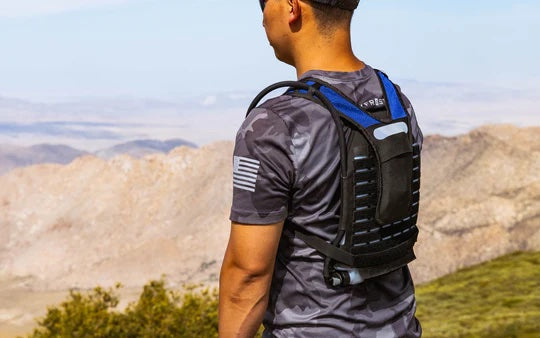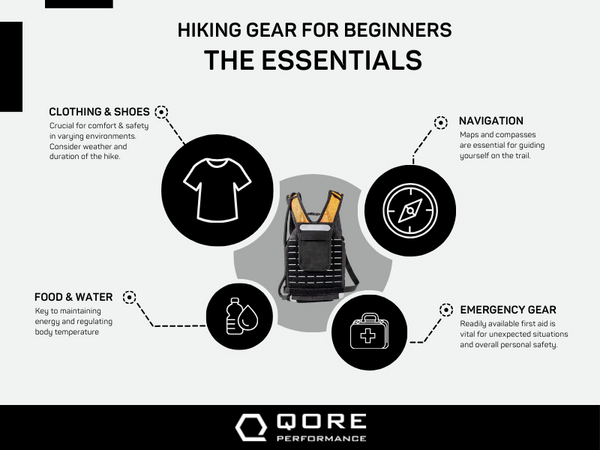Hiking Gear for Beginners

Hiking is the most popular outdoor sport in the United States. The barriers to entry are low: there are plenty of places to hike, it’s free, and it doesn’t require a high level of skill or athletic ability to participate. It does require some equipment, however, considering a hike can turn into a life-threatening situation in the blink of an eye.
Orthopedic injuries are one of the single biggest factors that turn a hiking trip into a rescue or an all-night stay in the woods. A simple rolled ankle can seriously slow your progress, keeping you in the woods in the path of oncoming weather. A broken leg can lock you down in place, wherever you are, leaving you at the mercy of the elements. Getting lost can keep you out longer than you intended, take you way off your course, and make getting found really difficult.
As a paramedic and paid Search & Rescue (SAR) professional, the single biggest piece of advice the author can give you is to let someone know where you’re going and when you expect to be back. This will let them alert rescuers and get them on their way to you. The second-best advice the author can offer is to bring the appropriate gear. Even if you’re just going out for a short day hike, having some life-saving gear can mean the difference between being relatively comfortable and safe, and struggling to stay alive long enough to get rescued.
Understanding Your Adventure
The most important gear you can have is not gear, it’s information. There are a lot of factors that go into assessing the difficulty of a hike. Even if you do know what to expect, conditions on the ground can change rapidly, and a trail may not even resemble the description in your app or guidebook. Therefore, it is always important to thoroughly prepare for your hikes.

Consider the Length of the Hike
First, you should take a look at how long the hike is. If you’re a brand-new hiker you probably shouldn’t tackle a 12-mile loop on your second outing. If you get into the middle of it and get a blister, realize you didn’t bring enough water, or simply become exhausted… well, it doesn’t matter because the options will be equally unappealing: go forward or go backward. Distance is not the only thing you need to pay attention to, though.
Consider Changes in Elevation on the Trail
Elevation is another huge factor. This is one that we often see overlooked in the mountains and it is responsible for a lot of “late hiker” calls. Hikers accustomed to hiking in the flatlands come to the mountains and realize that six miles with 3,500 feet of elevation gain is far from the same thing as six miles with 350 feet of elevation gain. It takes much longer and much more energy to accomplish the former and more than the simple back-of-the-envelope calculation would lead you to believe.
Don’t Forget About the Weather!
Weather is also a factor. When it is hot out you will exert yourself more and need to pay more attention to hydration and keeping your body cool. When it is cold out you need to maintain your body heat. Rain and snow can make a major dent in your fun, as well as rob a lot of precious heat from your body. Maintaining thermoregulation is critical to staying alive. Our revolutionary ICEPLATE® technology can help you stay cool and hydrated or warm and hydrated no matter where the trail takes you.
Essential Hiking Gear for Beginners
The essential hiking gear that every hiker should have can be broken out into a few categories. First is clothing and footwear. This is the gear you are going to be hiking in that will keep you comfortable, protect you from the elements, and help you regulate your body temperature. Next are navigation, food & hydration, and emergency equipment. Let’s take a closer look at each of these categories of essential hiking gear.

Hiking Gear for Beginners: Clothing & Footwear
Your clothing and footwear should facilitate thermoregulation. If you overheat or get too cold, your body is not going to be happy and your performance will suffer. If your temperature veers too far from 98.6 degrees you are going to have a serious medical emergency on your hands. Clothing should be selected based on your environment but there are some general principles. In cold, wet climates a waterproof outer layer is important. Some fabrics – notably Merino wool – are not waterproof, but still maintain some insulative value, even when wet. Still, other synthetics are fast-drying and wick moisture away. Synthetic insulation may help keep you warm when wet. Again, choosing the right combination of clothing is largely dependent on your environment.
Quality footwear is also critical to a successful first hike. Poorly constructed or ill-fitting footwear can cause blisters and make for a miserable experience. This effect becomes compounded on a long hike where little problems can become big problems in a hurry. Invest in a good pair of hiking boots or trail runners with good ankle support. If you are doing a winter hike, or if trail conditions are very wet you may opt for waterproof boots.
[Note: Waterproof boots typically come with extra cost and extra weight.]
Hiking Gear for Beginners: Navigational Equipment
Next up is navigation. This one is overlooked all too often. Inexperienced hikers will show up at the trailhead, see that the trail is marked and well-traveled, and that is as much navigational knowledge as they will seek. However, trail intersections can lead you astray, college kids steal marks and trail signs, and unmarked, unnamed “social” trails can confuse you, too. For beginner hikes, a hiker’s mapping app on your cell phone is usually sufficient. If you are a more experienced hiker and are taking on longer hiking trails, you should invest in a map and compass and learn how to use them. A GPS is also a really good idea. Regardless of what you choose, have a backup. Phone and GPS batteries can die, but we’ve also seen high-quality compasses fail for a variety of reasons. For that reason, make sure you bring multiple types of navigational equipment so you always have a failsafe.
Hiking Gear for Beginners: Food & Hydration
The next category – food & hydration – is the first thing most people think of when they think of going for their first hike. First, let’s be clear: hydration is more important than food by a large margin! Hydration allows your body to thermoregulate, keeps your blood thin, and helps your cognition… essentially, water keeps your body moving, and you need a lot of it. You can carry a water bottle, or you can also carry Qore Performance’s ICEPLATE®. ICEPLATE® harnesses the thermal power of water to cool/warm you while also providing a source of hydration that is far superior and easier to access than a water bottle. Carried in an IMS Sport Hydration Pack, this is the perfect hiking hydration setup.
Food is a secondary consideration, but you should have some to replenish energy levels. The longer the hike, the more important this becomes, but no matter how long your hike, you should have some energy-dense food. Trail mix, nuts, beef jerky, energy bars – all of these will do the trick, and depend on your personal preference. Make sure to throw in a few extras just in case you’re out longer than expected; a little something to eat helps morale if your adventure doesn’t go exactly as planned.
Hiking Gear for Beginners: Emergency Equipment
Finally, let’s talk about emergency equipment. This should include, at an absolute minimum, a first aid kit, a means of starting a fire, and some sort of shelter. The first aid kit should be capable of handling major bleeding and have any critical prescription medications you take. Fire-starting tools should be a source of flame (lighter or matches) and a source of tinder (the author recommends cotton balls smeared with Vaseline). A simple lighter has helped many lost hikers build a fire and stay alive long enough to be rescued. Finally, some sort of shelter to keep you dry, out of the wind, and let you preserve some body heat. This can be as simple as an emergency poncho or heavy-duty contractor garbage bag, or as complex as a tent. This also includes extra layers of clothing in case the temperature drops, and a rain jacket.
Gearing Up for Longer and More Challenging Hikes
Hikes can be made more difficult by length, elevation, trail conditions, and weather conditions. If you are doing some more challenging hikes, it is even more important to prepare appropriately. You will likely be further out into the backcountry where rescue is even more difficult and time-consuming should something go wrong. Not to mention, you want to stay as comfortable as possible during your hike.

Water Supply Becomes Even More Critical
You will almost certainly need more water, especially in warmer weather. Our ICEPLATE® and IMS Sport Hydration Pack are the ideal way to carry and consume water, but even the best water container will empty eventually. A critical piece of equipment on longer hikes is a method of procuring more water. Drinking water directly from its source is dangerous; there’s room for an entire article here, but water can contain feces (animal and human), animal carcasses, and more. A water filter will remove these pathogens and keep you safe when refilling your water supply.
Gear You Need for Overnight Hikes
On longer, overnight hikes you will probably need a tent and sleeping bag. On backpacking trips exceeding a few nights (like 2,100 miles along the Appalachian Trail) you will also need steady resupplies. Our guess is if you’re getting into a hike like that you are an experienced hiker and already have some idea of what to expect… right?
How Qore Performance Can Help
Proper hiking gear is vitally important. When you leave the pavement and hit rugged terrain the game changes. Mother Nature can be a harsh mistress, and you never know what will be thrown your way. First, inform yourself. Research your trail, the trail conditions, distance, elevation gain (and loss!), and look at the weather forecast. If you’re brand new, start with a short hike, and try not to do your first hike in either cold weather or hot weather.





Leave a comment